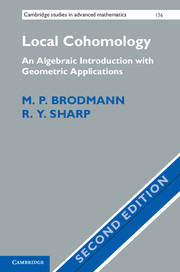Book contents
- Frontmatter
- Contents
- Preface to the First Edition
- Preface to the Second Edition
- Notation and conventions
- 1 The local cohomology functors
- 2 Torsion modules and ideal transforms
- 3 The Mayer–Vietoris sequence
- 4 Change of rings
- 5 Other approaches
- 6 Fundamental vanishing theorems
- 7 Artinian local cohomology modules
- 8 The Lichtenbaum–Hartshorne Theorem
- 9 The Annihilator and Finiteness Theorems
- 10 Matlis duality
- 11 Local duality
- 12 Canonical modules
- 13 Foundations in the graded case
- 14 Graded versions of basic theorems
- 15 Links with projective varieties
- 16 Castelnuovo regularity
- 17 Hilbert polynomials
- 18 Applications to reductions of ideals
- 19 Connectivity in algebraic varieties
- 20 Links with sheaf cohomology
- References
- Index
20 - Links with sheaf cohomology
Published online by Cambridge University Press: 05 December 2012
- Frontmatter
- Contents
- Preface to the First Edition
- Preface to the Second Edition
- Notation and conventions
- 1 The local cohomology functors
- 2 Torsion modules and ideal transforms
- 3 The Mayer–Vietoris sequence
- 4 Change of rings
- 5 Other approaches
- 6 Fundamental vanishing theorems
- 7 Artinian local cohomology modules
- 8 The Lichtenbaum–Hartshorne Theorem
- 9 The Annihilator and Finiteness Theorems
- 10 Matlis duality
- 11 Local duality
- 12 Canonical modules
- 13 Foundations in the graded case
- 14 Graded versions of basic theorems
- 15 Links with projective varieties
- 16 Castelnuovo regularity
- 17 Hilbert polynomials
- 18 Applications to reductions of ideals
- 19 Connectivity in algebraic varieties
- 20 Links with sheaf cohomology
- References
- Index
Summary
In this last chapter we shall develop the links between local cohomology and the cohomology of quasi-coherent sheaves over certain Noetherian schemes. Here we shall assume for the first time that the reader has some basic knowledge about schemes and sheaves: our reference for these topics is Hartshorne's book [30]. The central idea in this chapter is to extend our earlier relations in 2.3.2 and 15.1.3 between ideal transforms and rings of regular functions on varieties to quasi-coherent sheaves over certain Noetherian schemes. We shall be very concerned with a generalization of the ‘Deligne Isomorphism’ (see [30, Chapter III, Exercise 3.7, p. 217]) which links the group of sections (over an open subset) of an induced sheaf on an affine scheme with an ideal transform. More precisely, let denote the sheaf induced by an R-module M on the affine scheme Spec(R), and let U = Spec(R) \ Var(a), where a ⊂ R; then the group of sections Γ (U,) is isomorphic to the ideal transform Da(M). We shall use standard techniques involving negative strongly connected sequences of functors to extend this Deligne Isomorphism, and our generalization of it, to produce the Deligne Correspondence 20.3.11. This correspondence provides connections between higher cohomology groups of induced sheaves on the one hand, and local cohomology modules on the other.
We shall also examine the case when R is graded in some detail. Here the central result for us is the Serre–Grothendieck Correspondence 20.3.15, which we shall also derive from the Deligne Isomorphism by standard ‘connected sequence’ arguments.
- Type
- Chapter
- Information
- Local CohomologyAn Algebraic Introduction with Geometric Applications, pp. 438 - 479Publisher: Cambridge University PressPrint publication year: 2012

